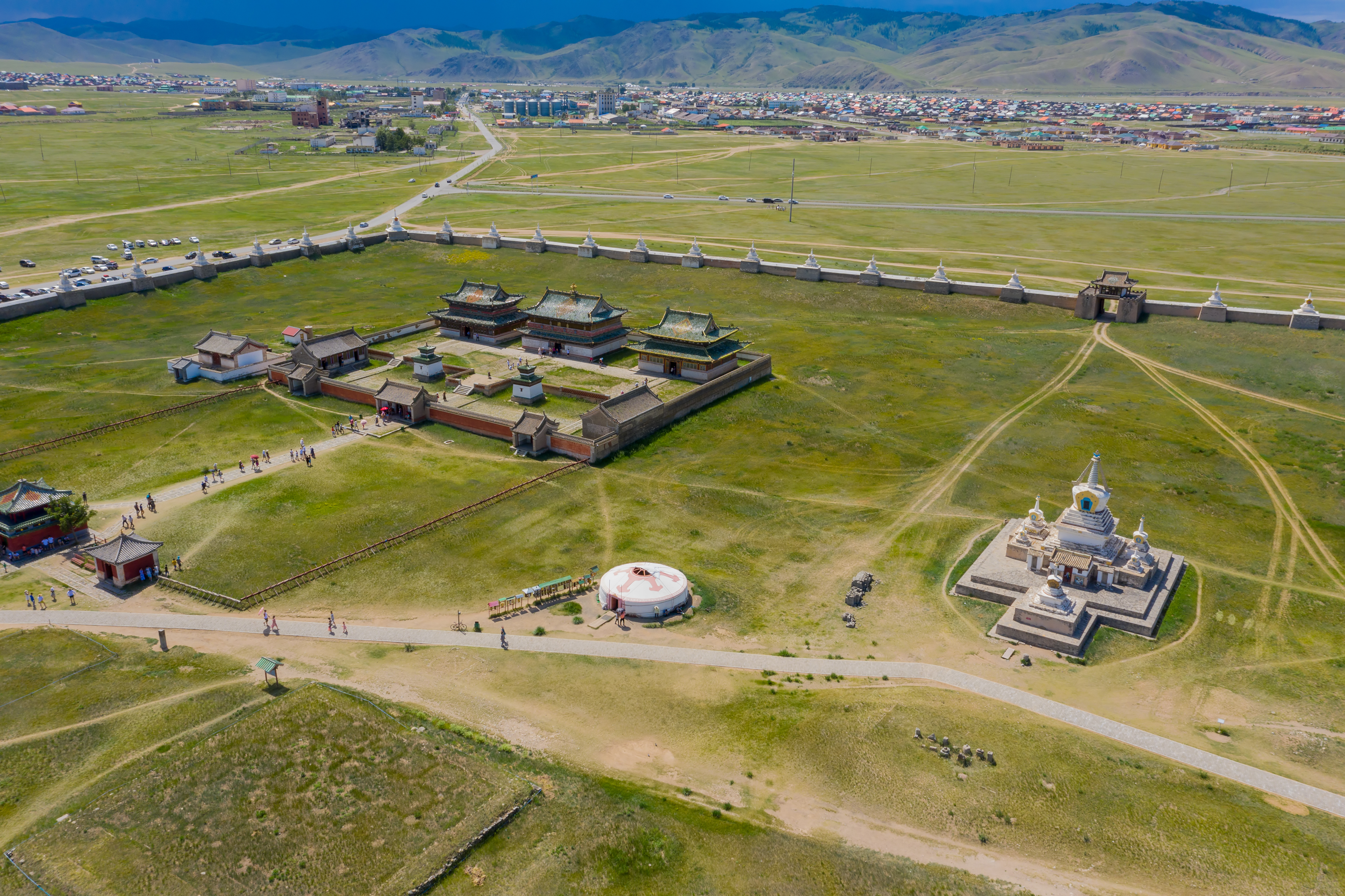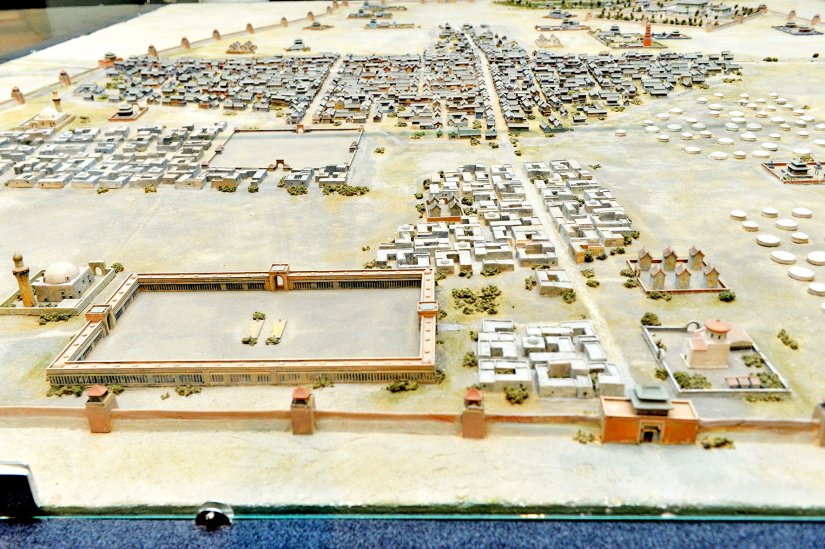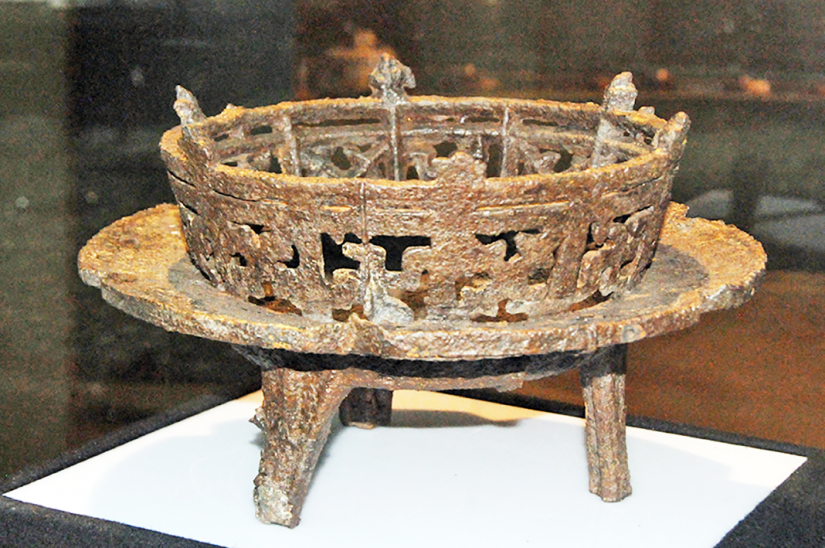Karakorum (Kharkhorin) in Uvurkhangai
founded by Genghis Khan in 1220
founded by Genghis Khan in 1220
Imagine walking through the ruins of an ancient city that once served as the heart of the mighty Mongol Empire. A city that stood at the crossroads of history and culture, where traders, artisans, and emissaries from the far corners of the world converged, sharing their knowledge, art, and beliefs. This is Karakorum, the legendary capital of Genghis Khan and his successors, nestled in the breathtaking Orkhon Valley of present-day Mongolia. In this blog post, we will embark on an exploration of Karakorum, delving into its rich history, architectural marvels, and archaeological discoveries that continue to shed light on this fascinating city.

Karakorum was not just another city; it was the embodiment of Genghis Khan’s vision for a new empire that would become the center of the world. Genghis Khan established the empire’s capital around 1220 CE, and Karakorum quickly grew in importance, attracting the best minds and talents from the vast territories under Mongol control.
This ancient city, located in the heart of Central Asia, witnessed the zenith of the Mongol Empire and became the bustling mongol capital, a hub of trade, diplomacy, and cultural exchange along the Silk Road.
The Orkhon River floodplain, where Karakorum would later be founded, was initially settled by the Uighur descendants of the Bronze Age Steppe Societies. These early settlers recognized the strategic importance of the area, which was ideally situated along the Silk Road and offered fertile land for agriculture. It was here, in the early 13th century, that Genghis Khan decided to establish the capital of his burgeoning empire.
Genghis Khan strategically chose Karakorum as the capital of his empire for several reasons:
The ambitious vision of Genghis Khan’s successors, especially his son, Ögedei Khan, drove Karakorum’s rapid expansion and development. Ögedei expanded the city, constructing buildings and attracting people of Chinese origin who brought valuable skills such as metalworking, pottery, and construction techniques. Foreign inhabitants, including Muslim merchants, diplomats, and craftsmen, flocked to the city, transforming it into a cosmopolitan hub that reflected the vastness and diversity of the Mongol Empire.
One notable foreign visitor to Karakorum was the 13th-century Flemish traveler William of Rubruck, who documented the city’s layout and vibrant atmosphere. He reported that Karakorum had:
These diverse religious and cultural institutions showcased the city’s openness and tolerance, which were hallmarks of the Mongol Empire.

Reflecting its status as the Mongol Empire’s capital, Karakorum was intricately planned and built. At its center stood the Khan’s palace, a magnificent complex that housed the empire’s rulers and served as the seat of power. Surrounding the palace were religious buildings, including Buddhist temples, mosques, and churches, which catered to the diverse beliefs and practices of the city’s inhabitants. The city was enclosed by a wall with four gates and a moat, providing a sense of security and grandeur befitting its importance.
Within the walls of Karakorum, neighborhoods were organized according to the different activities and trades that took place. Workshops and marketplaces bustled with merchants and craftsmen, while residential areas housed a diverse population of Mongols, Uighurs, Han Chinese, Persians, and Europeans. The city’s architecture reflected this diversity, with Chinese-style buildings, Islamic inscriptions, and Buddhist temples standing side by side in a testament to Karakorum’s unique cultural tapestry.
At the center of Karakorum was the palace complex, the residence of the Great Khan and the hub of political power. The Tumen Amgalan Ord palace, constructed by Gedei Khan in 1235, was a testament to the wealth and influence of the Mongol Empire. Its grandeur, unmatched and designed to impress the mongol elite, featured:
The palace walls were adorned with fine paintings by Khitan artists, showcasing the empire’s appreciation for art and craftsmanship.
One of the most striking features of the palace complex was the Silver Tree, an impressive mechanical tree with golden serpents around its trunk. When the emperor wished to serve drinks to his guests, a mechanical angel at the top of the tree would sound a trumpet, and the serpents’ mouths would pour out four different alcoholic beverages into silver basins at the base of the tree. This awe-inspiring marvel of engineering and artistry perfectly encapsulated the grandeur and sophistication of Karakorum’s palace complex.
Reflecting the Mongol Empire’s diversity, Karakorum was a crucible of various religious and cultural traditions, including mongolian indigenous religion. The city was home to numerous religious institutions, such as:
This religious diversity was indicative of the empire’s policy of religious tolerance, allowing its subjects to practice their faiths freely and without fear of persecution.
The presence of these diverse religious institutions in Karakorum not only showcased the city’s cosmopolitan nature but also fostered an environment of intellectual exchange and mutual understanding. This spirit of tolerance and openness contributed to the city’s vibrant atmosphere and its status as a center of cultural and religious exchange between East and West.
A blend of agriculture, trade, and skilled craftsmanship underpinned Karakorum’s economy. The city’s strategic location along the Silk Road made it an important hub for merchants and traders, who brought with them goods and raw materials from every corner of the empire. Local artisans produced a diverse array of products, including metalwork, pottery, and textiles, utilizing materials sourced from both local and exotic origins.
Agriculture also played a significant role in Karakorum’s economy. The Orkhon River provided a valuable source of water for irrigation, allowing for the cultivation of crops such as:
However, given the city’s size and population, most of the food had to be imported to support its inhabitants.
The cultivation of various crops in Karakorum included:
These crops were supported by the city’s irrigation system, which consisted of a sophisticated network of canals and ditches. This system brought water from the Orkhon River to the fields, allowing for the growth of crops in the fertile soil.
Despite the advanced irrigation system and local crop cultivation, most of the food required to sustain Karakorum’s population had to be imported. The city’s bustling trade and its location along the Silk Road helped facilitate the flow of food and other essential goods, ensuring that the city’s inhabitants were well-provided for.
Skilled artisans and workshops in Karakorum, a hub of art and craftsmanship, produced highly valued goods used within the city and across the Mongol Empire. Artisans worked with a variety of materials, including bronze, gold, copper, iron, gems, precious stones, bone, birchbark, and silk. These craftsmen created a wide range of products, such as glass beads, silk garments, fine porcelain, animal ginseng, furs, and deer horns.
The city’s workshops attracted merchants and traders from along the Silk Road, who brought with them exotic goods and raw materials, including imported Chinese silk, for the artisans to work with. This vibrant trade and the exchange of ideas and techniques among artisans contributed to the city’s thriving economy and its reputation as a center of art and culture.
The late 13th-century decline and abandonment of Karakorum signified a historical turning point for the Mongol Empire. Following the death of Monke Khan, a power struggle between Khubilai and Arik Boke for the throne resulted in the latter’s defeat. Consequently, Khubilai, also known as Kublai Khan, decided to build his own capital city, Khanbalik (present-day Beijing), in 1272, leaving Karakorum behind. Under Kublai Khan’s orders, the city was plundered and almost destroyed, signaling the end of its prominence as the Mongol Empire’s capital.
The decline of Karakorum had significant consequences for the Mongol Empire’s control over western Asia. As the empire’s central authority weakened, its grip on its vast territories began to loosen, leading to fragmentation and the eventual disintegration of the empire.
Shifting the capital to Khanbaliq kick-started a period of decline and decentralization for the Mongol Empire. As the empire grew increasingly reliant on its Chinese territories and the resources provided by the newly-established Yuan Dynasty, its control over its western territories began to wane. This loss of centralized authority led to disputes over succession, the deterioration of the Silk Road’s security, and the eventual fragmentation of the empire into smaller, less cohesive units. It was during this time that the mongol empire occurred in a state of decline and fragmentation.
The decline of Karakorum had cultural implications for the Mongol Empire, including:

Studying the archaeological remains of Karakorum has yielded precious insights into the city’s history, layout, and day-to-day life. Excavations conducted by international teams from Mongolia, Russia, and Germany have unearthed a wealth of information about the city, from its architectural marvels to the artifacts left behind by its inhabitants. These discoveries have helped to paint a vivid picture of life in this ancient capital, offering glimpses into the city’s diverse population, religious practices, and economic activities.
Through the ongoing study of Karakorum’s archaeological remains, researchers hope to further unravel the city’s mysteries and gain a deeper understanding of the Mongol Empire’s impact on the region. The city’s ruins continue to captivate scholars and visitors alike, serving as a testament to the enduring allure of Karakorum and its fascinating history.
International teams from Mongolia, Russia, and Germany have been conducting excavations at the Karakorum site since the 19th century, revealing abundant information about the city’s history, architecture, and daily life. Among the most significant discoveries are brick and adobe buildings, buildings with floor heating systems, and remnants of precious metal processing tools, which provide valuable insights into the city’s construction techniques and industries.
These international research efforts have not only shed light on the city’s history but have also fostered collaboration and exchange between scholars from different countries. As researchers continue to delve into Karakorum’s past, they hope to further unravel the city’s mysteries and deepen our understanding of the Mongol Empire’s impact on the region.
Key archaeological discoveries in Karakorum include:
These discoveries offer insights into the diverse population and activities of the city. The palace complex, once the heart of the city and the seat of power for the Great Khan, has been the focus of detailed excavations, revealing a vast complex of buildings and courtyards.
Other significant finds include the remnants of religious edifices such as Buddhist temples, Muslim cemeteries, and Christian churches, which reflect the city’s religious diversity. Additionally, artifacts such as coins, pottery, and tools have been unearthed, offering insights into the city’s multifaceted population and their various trades and occupations.
These discoveries continue to provide valuable information about life in Karakorum during its heyday, allowing us to better understand this ancient capital and its place in history.
Modern Karakorum today presents a unique opportunity for visitors to explore remnants of the ancient capital and delve into its captivating history. The city’s ruins, including the Erdene Zuu Monastery, the old city walls, and the remains of the palace complex, stand as testament to its former glory and the enduring allure of its past. As you walk among the ruins, it is easy to imagine the bustling markets, vibrant workshops, and diverse population that once called this city home.
Visiting Karakorum is not only a journey into the past, but also an opportunity to experience the beauty of Mongolia’s Orkhon Valley and its rich cultural heritage. Whether you’re an avid history buff, an intrepid traveler, or simply curious about the Mongol Empire, Karakorum will surely captivate your imagination and leave you with a deeper appreciation for the city’s storied past.
June and September, when the weather is most favorable, are the best months to visit Karakorum. During these months, temperatures are comfortable, making it an ideal time to explore the city’s ruins and surrounding countryside.
Keep in mind that the weather in Mongolia can be unpredictable, so it’s always a good idea to check local forecasts and pack accordingly.
Several accommodations are available when planning your visit to Karakorum, such as the four-star hotel in Kharkhorin, local guesthouses, and campsites. These accommodations offer various amenities such as gardens, terraces, restaurants, free WiFi, and free parking to ensure a comfortable and enjoyable stay during your visit to this historic city.
What was the role of Karakorum in the Mongol Empire?
Karakorum was the capital of the Mongol Empire and served as a significant center for diverse religious practices and mercantile trade along the Silk Road.
What were the main industries in Karakorum?
Metalworking was the primary industry in Karakorum, with artisans producing goods from local and exotic materials.
What is the Erdene Zuu Monastery?
The Erdene Zuu Monastery is the oldest Buddhist monastery in Mongolia, located in Karakorum.
How long does it take to drive from Ulaanbaatar to Karakorum?
The drive from Ulaanbaatar to Karakorum takes approximately 6-7 hours, covering a distance of around 370 kilometers.
When is the best time to visit Karakorum?
June and September, when the weather is most favorable, are the best months to visit Karakorum.
If you’re planning to drive from Ulaanbaatar to Karakorum, expect the journey to take around 6-7 hours, covering a distance of approximately 370 kilometers. Be sure to plan your route ahead of time, ensure that you have sufficient fuel and provisions for the trip, and familiarize yourself with local traffic regulations.
The drive offers a unique opportunity to experience Mongolia’s breathtaking landscapes and immerse yourself in the country’s rich cultural heritage.
From its establishment by Genghis Khan to its eventual decline and abandonment, the city of Karakorum stands as a testament to the power and influence of the Mongol Empire. Through its diverse population, vibrant economy, and awe-inspiring architecture, Karakorum played a pivotal role in shaping the course of history along the Silk Road. Today, the city’s archaeological remains continue to offer valuable insights into its past and provide a unique opportunity for visitors to explore the ancient capital’s rich heritage.
As we conclude our journey through Karakorum, it’s important to remember that the city’s story is not just one of power and conquest, but also one of cultural exchange, tolerance, and intellectual growth. In its heyday, Karakorum was a beacon of knowledge, art, and commerce, a place where people from different walks of life came together to share their ideas and beliefs. This spirit of openness and curiosity is something that still resonates today, making Karakorum a fascinating and inspiring destination for all who visit.
Karakorum, now known as Harhorin, is located in Orkhon Valley of central Mongolia and was the capital of the Mongol Empire founded by Genghis Khan. From 1235 to 1263, it served as the capital of the Mongol Empire, established by Genghis Khan.
Yes, Karakorum still exists as ruins since it was founded by Genghis Khan in 1220 C.E. and is visible on the Earth's surface today.
Karakorum was a significant city in the history of the Silk Road and was founded by Genghis Khan in 1220. Under his son gedei, Karakorum became the capital of the Mongol Empire and an important centre of diverse religious microcosm and mercantile trade. It was a major hub for the exchange of goods, ideas, and cultures between East and West. It was also a place of great religious diversity, with Buddhists, Muslims, and Christians all living and trading in the
Karakorum was abandoned after Chinese forces invaded and won a decisive victory in the Battle of Puir Nor in 1388, razing the city to the ground. Later it was partially rebuilt, however the city had difficulty feeding its population due to its dry climate and was eventually left abandoned.
Karakorum was the capital of the Mongol Empire, playing a key role in facilitating religious diversity and trade along the Silk Road.
Travelling to Mongolia and need a car rental plus extra equipments?